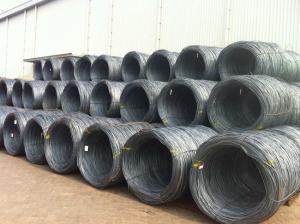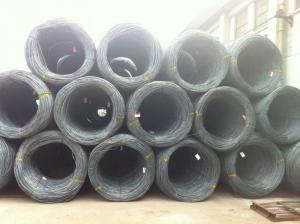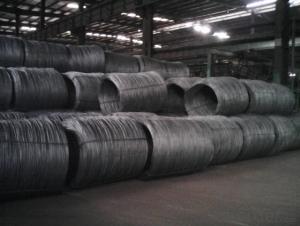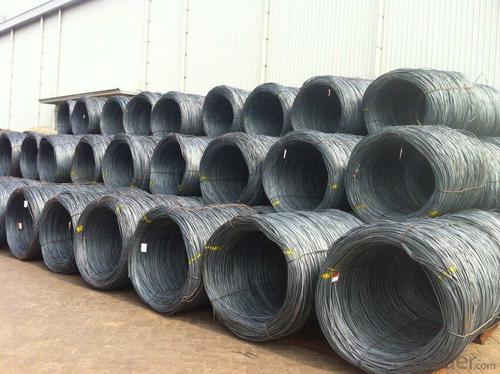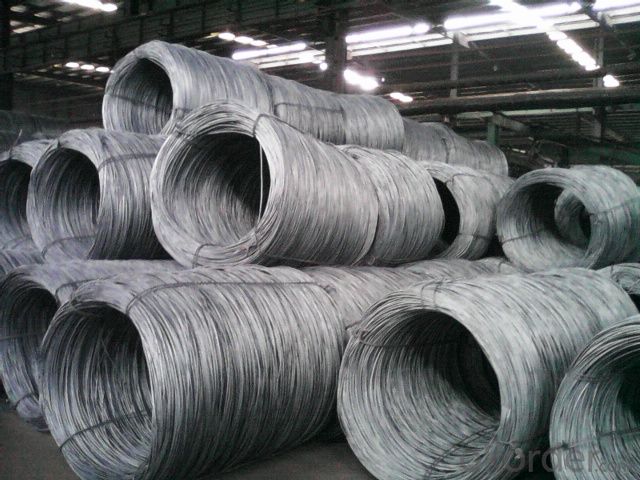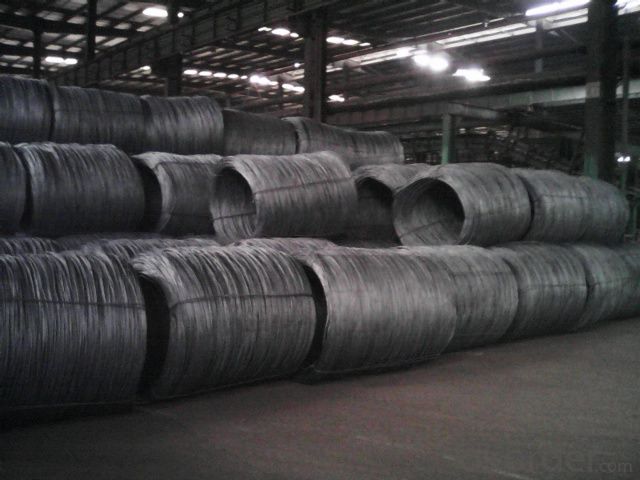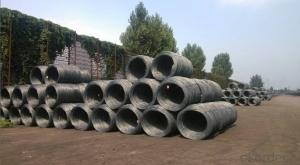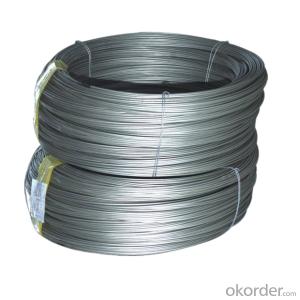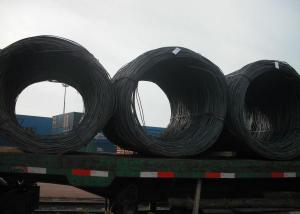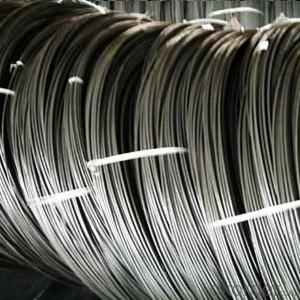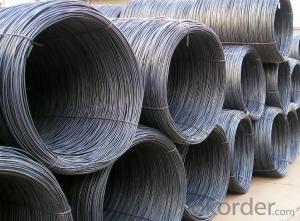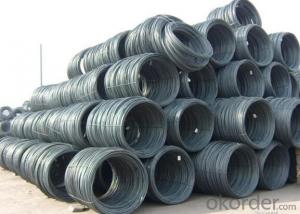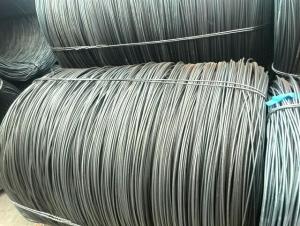Q195 WIRE ROD WITH HIGH QUALITY
- Loading Port:
- China Main Port
- Payment Terms:
- TT or LC
- Min Order Qty:
- -
- Supply Capability:
- -
OKorder Service Pledge
OKorder Financial Service
You Might Also Like
Product Description:
OKorder is offering Q195 WIRE ROD WITH HIGH QUALITY at great prices with worldwide shipping. Our supplier is a world-class manufacturer of steel, with our products utilized the world over. OKorder annually supplies products to European, North American and Asian markets. We provide quotations within 24 hours of receiving an inquiry and guarantee competitive prices.
6.5mm can be drawing into 2mm/8.0mm can be drawing into 3mm
Type: Drawn Wire in Coil, each coil weight about 2MT
Brand Name: N-RIVER Place of Origin: Hebei, China
Chemical Composition:
Please kindly find our chemistry of our material based on Q195 as below for your information
Trademark | Rank | Chemical composition (quality score) % | |||||
C | Si | Mn | S | P | |||
| ≤ |
| ≤ | ≤ | |||
Q195 |
| 0.06-0.12 | 0.30 | 0.25 | 0.050 | 0.045 | |
Trademark | Rank | Pulling Test | |||||
Bend PointΔs/Mpa | Tensile Strength | Elongation Ratioδ5% | |||||
Thickness (Diameter) /MM | Thickness (Diameter) /MM | ||||||
≤16 | 16-40 | ≤16 | 16-40 | ||||
≥ | ≥ | ||||||
Q195 |
| 195 | 185 | 315-390 | 33 | 32 | |
Product Applications:
Q195 WIRE ROD WITH HIGH QUALITY are ideal for structural applications and are widely used in the construction of buildings and bridges, and the manufacturing, petrochemical, and transportation industries.
Product Advantages:
OKorder's Q195 WIRE ROD WITH HIGH QUALITY are durable, strong, and resist corrosion.
Main Product Features:
· Premium quality
· Prompt delivery & seaworthy packing (30 days after receiving deposit)
· Corrosion resistance
· Can be recycled and reused
· Mill test certification
Product Specifications:
Diameter: 5.5mm, 6.5mm, 7mm,8mm,9mm,10mm,12mm,14mm
FAQ:
Q1: What makes stainless steel stainless?
A1: Stainless steel must contain at least 10.5 % chromium. It is this element that reacts with the oxygen in the air to form a complex chrome-oxide surface layer that is invisible but strong enough to prevent further oxygen from "staining" (rusting) the surface. Higher levels of chromium and the addition of other alloying elements such as nickel and molybdenum enhance this surface layer and improve the corrosion resistance of the stainless material.
Q2: How do we guarantee the quality of our products?
A2: We have established an advanced quality management system which conducts strict quality tests at every step, from raw materials to the final product. At the same time, we provide extensive follow-up service assurances as required.
Q3: Can stainless steel rust?
A3: Stainless does not "rust" as you think of regular steel rusting with a red oxide on the surface that flakes off. If you see red rust it is probably due to some iron particles that have contaminated the surface of the stainless steel and it is these iron particles that are rusting. Look at the source of the rusting and see if you can remove it from the surface.
Images:
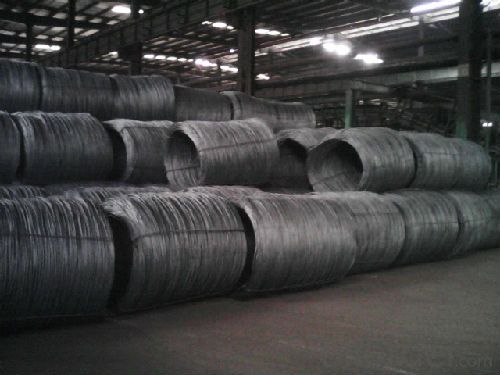

- Q: What are the different types of steel wire rod alloys?
- There are several different types of steel wire rod alloys, including carbon steel, stainless steel, alloy steel, and tool steel.
- Q: How is steel wire rod used in the production of wire strands for cable-stayed bridges?
- The production of wire strands for cable-stayed bridges relies heavily on steel wire rod. These wire strands are essential for ensuring the bridge's structural stability and load-bearing capacity. To start, steel wire rods are carefully manufactured with specific chemical compositions and mechanical properties to guarantee their suitability for this application. Typically, these wire rods are made from high-strength steel alloys like carbon or alloy steel, which can withstand the immense tension and stress experienced by cable-stayed bridges. The initial stage of the production process involves reducing the diameter of the steel wire rod by drawing it through a series of dies. This process, known as wire drawing, aligns the crystal structure of the steel and eliminates impurities, thereby imparting a higher tensile strength to the wire strand. As a result, the wire strand becomes capable of withstanding significant loads. After the wire strands are formed, they undergo galvanization or coating with a corrosion-resistant material. This protective layer shields the steel from environmental factors like moisture and chemicals, which could cause corrosion and compromise the bridge's integrity. Once the wire strands have been coated, they are assembled into bundles to form the main supporting structure of the cable-stayed bridge. The number of wire strands used, as well as their arrangement and tensioning, depend on the specific design requirements of the bridge. Typically, these wire strands are anchored to the bridge deck and tower, providing support and evenly distributing the load across the structure. The final step involves tensioning the wire strands to their specified levels, ensuring that they can bear the anticipated loads and maintain the stability of the bridge. This tensioning process is crucial for achieving the desired sag and shape of the bridge, as well as evenly distributing the forces among the wire strands. In conclusion, steel wire rod plays a critical role in the production of wire strands for cable-stayed bridges. It provides the necessary strength and durability to withstand the immense loads and forces exerted on these structures. Through various manufacturing processes, the wire rod is transformed into wire strands that are galvanized, bundled, and tensioned to create a stable and reliable supporting system for cable-stayed bridges.
- Q: How is steel wire rod used in the production of wire mesh for animal enclosures?
- Steel wire rod is used as the primary raw material in the production of wire mesh for animal enclosures. It is first drawn through a series of dies to reduce its diameter and increase its length. This process helps to enhance the wire's strength and flexibility. The resulting thin and long steel wires are then woven or welded together to create a grid-like structure, forming the wire mesh. This sturdy and durable mesh is commonly used to construct animal enclosures as it provides a secure boundary, preventing animals from escaping while still allowing air circulation and visibility.
- Q: How is steel wire rod processed to achieve specific properties?
- Steel wire rod is processed through a series of manufacturing steps to achieve specific properties that make it suitable for various applications. The process begins with the selection of high-quality raw materials, typically low carbon steel, which is melted in a furnace to create molten steel. Once the molten steel is produced, it is then continuously cast into billets or blooms, which are solidified and then rolled into wire rod form through hot rolling. This hot rolling process involves passing the billets or blooms through a series of rollers to reduce their size and shape them into the desired wire rod dimensions. This step helps align the grain structure of the steel, improving its strength and ductility. After hot rolling, the wire rod undergoes a cooling process to relieve any residual stress and ensure dimensional stability. It is then subjected to a surface treatment, such as pickling or shot blasting, to remove any oxides or scale formed during the hot rolling process. To achieve specific mechanical properties, the wire rod may undergo further processing steps, such as cold drawing or heat treatment. Cold drawing involves pulling the wire rod through a series of dies to reduce its diameter, increase its tensile strength, and improve its surface finish. Heat treatment, on the other hand, involves subjecting the wire rod to controlled heating and cooling cycles to modify its microstructure, resulting in desired properties like hardness, toughness, or corrosion resistance. Additionally, the wire rod may undergo additional surface treatments, such as coating or galvanizing, to enhance its corrosion resistance or improve its aesthetic appearance. Coating can involve applying a layer of zinc, polymer, or other protective materials, while galvanizing involves immersing the wire rod in a bath of molten zinc to create a protective zinc coating. Overall, the processing of steel wire rod involves a combination of hot rolling, cooling, surface treatment, and potential further processing steps like cold drawing or heat treatment. These steps are carefully implemented to achieve specific properties, such as strength, ductility, corrosion resistance, and surface finish, making the wire rod suitable for diverse applications in industries like construction, automotive, manufacturing, and more.
- Q: What are the different grain size measurement methods for steel wire rod?
- Steel wire rod is commonly measured using various grain size measurement methods. These methods provide crucial information about the microstructure and mechanical properties of the steel. One method widely utilized is the ASTM E112 standard, which employs a microscope to measure the average grain size. To apply this method, a metallographic sample is prepared and polished to a mirror-like finish. Subsequently, the sample is etched to reveal the grain boundaries. Under a microscope, the grain boundaries are then traced and counted to determine the average grain size. Another technique is the Sieve Analysis method, frequently employed to determine the grain size distribution in steel wire rod. This method entails sieving a representative sample of the wire rod through a series of progressively smaller mesh sieves. The weight of material retained on each sieve is measured, and the grain size distribution is determined based on the percentage of retained material. The Laser Diffraction method is another frequently used approach for measuring grain size in steel wire rod. In this method, a suspension of wire rod particles is subjected to a laser beam, and the resulting scattering pattern is measured. Particle size can be determined based on the diffraction pattern, allowing for the calculation of the grain size distribution. Additional methods include the Electron Backscatter Diffraction (EBSD) method, which utilizes an electron microscope to determine crystallographic orientation and grain boundaries in the wire rod, and the X-ray Diffraction (XRD) method, which measures the angle of X-ray diffraction to determine crystallographic structure and grain size. Each of these grain size measurement methods possesses distinct advantages and limitations. The choice of method depends on factors such as the desired level of accuracy, the type of steel wire rod being analyzed, and the available equipment and expertise.
- Q: What are the major steel wire rod consuming countries?
- The major steel wire rod consuming countries include China, the United States, Japan, India, and South Korea.
- Q: What are the main factors influencing the choice of steel wire rod order replacement policy?
- Several factors play a significant role in the decision-making process when it comes to choosing a replacement policy for steel wire rod orders. These factors include market demand, production capacity, inventory management, and cost considerations. Market demand is a crucial factor that determines the replacement policy for steel wire rod orders. The level of customer demand influences the frequency and volume of orders required. If there is high demand and a rapid turnover of inventory, a more frequent replacement policy may be necessary to meet customer needs. Production capacity is another essential factor to consider. The ability of the steel wire rod manufacturer to produce and deliver orders on time affects the replacement policy. If production capacity is limited, more frequent orders may be needed to avoid stockouts and ensure a steady supply. Effective inventory management is also critical in determining the replacement policy. It involves maintaining an optimal inventory level to avoid excess or shortage. By analyzing historical demand patterns and lead times, companies can develop inventory management strategies that minimize stockouts while reducing carrying costs. The replacement policy must align with these objectives. Cost considerations also play a significant role. Companies need to evaluate the costs associated with frequent orders, such as administrative expenses and transportation costs, against the benefits of maintaining a steady supply. Additionally, the cost of holding excess inventory and the risks of obsolescence or deterioration should be taken into account. A comprehensive cost-benefit analysis should determine the most appropriate replacement policy. In conclusion, market demand, production capacity, inventory management, and cost considerations are the main factors influencing the choice of steel wire rod order replacement policy. By carefully considering these factors, companies can develop a policy that ensures a consistent and sufficient supply of steel wire rods while optimizing operational efficiency and cost-effectiveness.
- Q: What are the common types of steel used for wire rod production?
- The common types of steel used for wire rod production include carbon steel, alloy steel, and stainless steel. Carbon steel is the most widely used type due to its affordability and versatility. It is primarily composed of iron and carbon, with small amounts of other elements. Alloy steel, on the other hand, is a combination of iron and other elements such as manganese, chromium, or nickel. This type of steel is known for its enhanced strength, durability, and resistance to wear and tear. Stainless steel is another commonly used type for wire rod production, particularly in applications where corrosion resistance is essential. It contains a high amount of chromium, which forms a protective oxide layer on the surface, preventing rust and corrosion. These different types of steel offer varying properties and characteristics, allowing manufacturers to cater to specific requirements for wire rod production in various industries.
- Q: What are the main factors influencing the choice of steel wire rod dimensions?
- The dimensions of steel wire rods are determined by various factors, including the intended application, the required mechanical properties, and the manufacturing process. To begin with, the dimensions of the steel wire rod are heavily influenced by the intended application. Different industries and products have specific requirements for the dimensions of the wire rod. For instance, the automotive industry uses steel wire rods for manufacturing springs, cables, and reinforcements, and these dimensions need to be customized to fit the specific components. Similarly, the construction industry utilizes steel wire rods for reinforcing concrete structures, and the dimensions must be suitable for achieving the desired strength and stability. Additionally, the required mechanical properties of the steel wire rod also impact its dimensions. Factors like tensile strength, yield strength, elongation, and ductility are taken into consideration when determining the dimensions. If higher strength is needed, a thicker wire rod may be necessary, while greater ductility may require a thinner rod that can be easily shaped or bent. Lastly, the choice of steel wire rod dimensions is influenced by the manufacturing process. The capabilities of the production line and the available equipment play a significant role in determining the dimensions. The dimensions must align with the production process to ensure efficient and cost-effective manufacturing. For example, if a specific wire rod dimension is not compatible with the existing rolling mill equipment, it may require additional investments or modifications to accommodate the desired dimensions. In conclusion, the dimensions of steel wire rods are influenced by the intended application, the required mechanical properties, and the manufacturing process. Considering these factors guarantees that the wire rod is suitable for its intended use, meets the necessary performance criteria, and can be manufactured efficiently.
- Q: How is steel wire rod packaged and shipped?
- Steel wire rod is typically packaged and shipped in coils or bundles. The wire rod is first coiled into large coils, often weighing several tons, or bundled together into smaller, more manageable bundles. These coils or bundles are then securely strapped or bound with steel bands or wires to ensure they stay intact during transportation. To protect the wire rod from corrosion and damage, it is often further wrapped in protective materials such as plastic or cardboard. Finally, the packaged wire rod is loaded onto trucks, trains, or shipping containers for transportation to its destination.
Send your message to us
Q195 WIRE ROD WITH HIGH QUALITY
- Loading Port:
- China Main Port
- Payment Terms:
- TT or LC
- Min Order Qty:
- -
- Supply Capability:
- -
OKorder Service Pledge
OKorder Financial Service
Similar products
Hot products
Hot Searches
Related keywords
